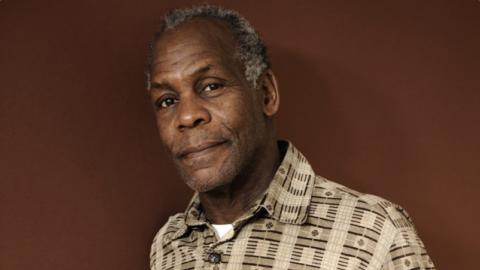Interview: Lucrecia Martel
“There are many ways in which Zama, [Lucrecia] Martel’s first feature in nine years, represents a departure for the Argentine writer-director,” I wrote in “When All Is Lost,” my September/October 2017 Film Comment feature on Martel’s new film about a frustrated functionary of the Spanish crown who wastes away in colonial-era Argentina. “It is her first literary adaptation [of Antonio Di Benedetto’s eponymous 1957 novel], her first period film, her first film with a male protagonist, her first film in which widescreen compositions largely emphasize verticality instead of horizontality, and her first feature to be set outside of her native province of Salta. Yet, while Zama represents a new frontier for Martel, it also continues and even deepens her singular, allusive approach to class, gender, race, and place, as well as still more cryptic notions of destiny and vocation.”
Martel and I met for an interview in early September during the 42nd Toronto International Film Festival, where Zama had its North American premiere as part of TIFF’s “Masters” program. We alternated between English and Spanish. What follows contains material translated by myself and Peter Goldberg.
A retrospective of Lucrecia Martel’s films run April 10–15 at the Film Society of Lincoln Center; Zama opens on April 11.
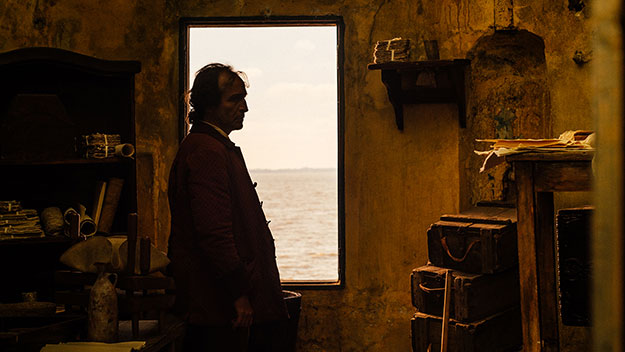
I’d like to speak with you about a knotty subject, that of the Argentine character.
Ah-ha!
There is a moment in Zama in which the poised and seductive Luciana Piñares de Luenga—a Spanish national temporarily stationed in the South American backwater where much of the action takes place—says to Zama, an americano, or one born in the Americas: “Europe is best remembered by those who were never there.”
This is Argentina.
I feel like, if we were to place your films in historical chronological order, we could trace a line that goes straight from Zama to La Ciénaga, an unbroken line of people who, despite hundreds of years of geography, refuse to think of themselves as americanos. They want to think of themselves as Europeans enduring some protracted exile.
Ah, yes! At the beginning of La Ciénaga there is a picture of my grandmother in the snow. There is snow and a dog. And there is some dialogue about snow in Zama, too. There is a line between these films. You’re right.
How did your grandmother feel about snow?
She said that snow is elegant. We don’t have snow in Argentina. Not in the North, where I’m from. Snow, for us, is Europe. So snow is elegant. We want to be Europeans. For us, the middle- and upper-middle class in Argentina, the descendants of immigrants, snow is Europe. And it’s white. We have a middle- and upper-middle class that’s mostly white and a lower social class that is predominantly indigenous. It’s this that perpetuates the racism and prejudice that we haven’t been able to abandon. This attitude is not just deep but foundational: the upper classes’ inability to identify with the lower class. Which form the majority of the country.
When I saw Zama, and even before, when I read Antonio Di Benedetto’s novel, I felt the story was tapping directly into the origins of this anxiety of identity. “Am I European? Am I Latin American?” Was that something that attracted you to the book?
It was the main point for me. When talking to me about Zama, everybody talks about the waiting. La espera. The waiting doesn’t exist if there isn’t this question of identity. If someone doesn’t believe, they don’t hope for anything. The firmer the identity, the harder it is to satisfy that hope. So in this way, what interests me about the character of Zama is that if he surrendered his existence to his surroundings, he’d be much less dissatisfied. For me, our country is dissatisfied because it’s in Latin America when it should be in the peninsula! [Laughs] It’s like a fantasy. And this perpetually pushes us toward failure. In Argentina, identity is something that gets talked about a lot. It’s an absurd, nationalistic identity. It’s not a healthy identity. To many Argentines, the problems of indigenous people seem like anachronisms, like something that doesn’t accord with what it is to be Argentine. In Argentina there still exist very serious problems concerning ownership of the land that even after 200 years of independence have yet to be resolved. We can’t resolve them because we don’t recognize the indigenous community as our own, as what we are.
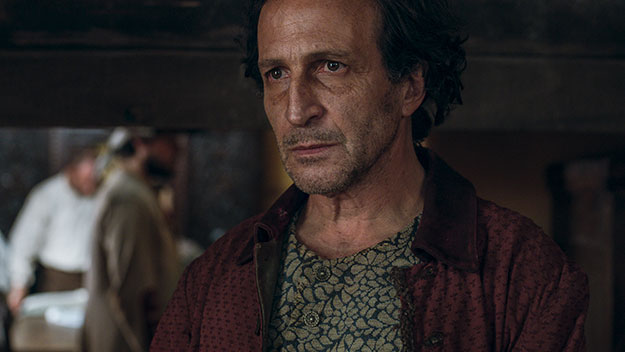
I think these ideas are expressed in Zama through the aligning of soil and flesh. We have this land that’s suffering the injuries of colonization and development, and we also have maimed feet, chopped-off hands, an ear that’s been removed, a tongue that’s unable to speak. I can’t remember if all these are in the novel or if some are things that you added.
You know, sometimes I can’t remember. There are some inventions. I think the ear of Vicuña Porto was our invention. Maybe the feet, too. Now it’s difficult to distinguish. Suppose it’s my invention—it’s a motivated invention. That is to say, when one reads a novel and enters that insanity many things that you can’t invent surge up from this intoxication. They come to me because I’m in Antonio Di Benedetto’s world.
But some of the discrepancies between the novel and the film are very interesting. For instance, all of your previous films are, of course, set in your home province of Salta. You changed Zama’s desired destination from Buenos Aires to Lerma, which is a town in Salta. Did you just want to keep one toe in Salta?
Yes! [Laughs] The period in which I developed Zama were years where I had a lot of anguish about returning to Salta. I had such a strong desire to return, but it took time to decide, and my inability to decide linked me to Zama and that’s why I changed the place where to longs to be transferred to Lerma.
Another interesting difference concerns this lover with whom Zama has a child. In the novel it specifically says that she’s a Spanish woman. In the film, she’s clearly indigenous.
That I did it because it seemed like it would be better to be more contradictory. In the novel, Zama was not capable of resolving this question of having another family but still wanting to go, but in the film it makes sense that he might have a mestizo son, as opposed to a white son, and still want to leave.
This change also addresses a contradiction between what Zama tells himself and what he actually does. It addresses the question of first person and the unreliable narrator. I wonder what your strategy was with regard to translating the novel’s use of first person into film.
We had this idea before writing the script to render everything Zama describes as though it were real. The way to do this was to turn many dialogues into voiceovers that would play on top of the close-ups of Zama. Inevitably this was going to result in the feeling that all these voices were a single voiceover, that all of those voices are one voice.
Sound does strike me as the key component is conveying Zama’s subjective experience. There’s this descending electronic sound that you employ three or four times.
Ohhhh! The Shepard tone!
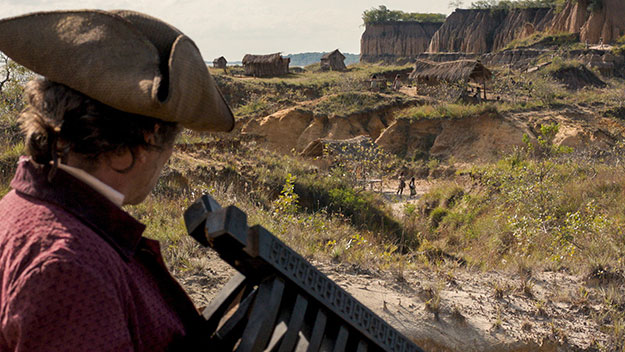
What is that for you?
The Shepard tone is an auditory illusion that seems like a constant falling pitch. One that never ends. Falling, falling, falling, falling, falling, falling, falling. So, it’s an ideal sound for Zama. It seemed like Zama’s sound to me. This sensation that there is no bottom. When [editor] Miguel [Schverdfinger] and [sound designer] Guido [Berenblum] and I came to this decision to use this effect, we called it borbuja, bubble. We wanted bubble moments where that happened. [Makes bubbling sound]
I believe the only other explicitly non-diegetic sounds in the film are the songs by Los Indios Tabajaras. They also constitute the only real anachronism in Zama. I would love to know why you chose those songs, “Maria Elena” and so on.
Los Indios Tabajaras are from the same time during which the novel was written. They were a very popular duo in Brazil that almost certainly crossed over to Argentina. I can’t verify this, but I imagine that Di Benedetto probably would have heard Los Indios Tabajaras in his time and that idea seemed interesting. [The years] 1790, 1957, and 2017: that combination seemed extraordinary to me. And another thing: Los Indios Tabajaras were a duo that exalted their indigenous origins but had a big desire to make it in Hollywood. It’s just like Yma Súmac. She was the Incan princess. A lot of Hollywood movies used her music for its exoticism. And Los Indos Tabajaras exploited this exoticism all over the world. They worked a lot in European TV and also in the United States.
I can only imagine that in Argentina it’s difficult to have a career in the arts if you don’t live in Buenos Aires. You went to Buenos Aires, you left Buenos Aires. Di Benedetto, who was from Mendoza, seemed to refuse to participate in the literary life of Buenos Aires. Such regionalism makes it tough to gain notoriety, no?
Yes. In fact, this great writer only became well-known and his books more available some 70 years after Zama.
Zama was only just translated into English for the first time. It’s crazy.
Yes. But the strange thing is that at the time that Zama was first published, it was immediately translated to German.
Do you feel connected to Di Benedetto this way? Do you feel like being a regional artist is an important part of what you do?
Yes, because this craziness, this pro-European craziness, which is today a more pro-American craziness, is different in Argentina’s interior. The interior is separate. We call the interior whatever is not Buenos Aires. And within the interior, the North is more Latin American because there’s a bigger indigenous presence in the culture. There is also more racism. Also, when one is from the interior they’re sort of put in a different class. It’s a little outside the great Argentine destiny that awaits you in Buenos Aires. Yes, I feel that I share this with Di Benedetto, not being from the cultural center of our country.
I sense you’re happy having left Buenos Aires.
It’s not only that, but I also like that my references for my films are more regional things. I feel that there’s a world there that hasn’t been so narrativized. By simply taking a deeper interest in the regional, a film gains a particularity. Visually, aurally. And it seems to me that the cinematic notion of universality doesn’t exist. I think this is an absurd fantasy. It winds up not meaning anything for anyone. I think that things that pertain to a few very small locations end up being more genuinely universal.
Zama is your first period film, your first adaptation, your first film with a male protagonist. But I also feel that Zama is notable for being your first vertical film. La Ciénaga especially is a really horizontal movie.
Really?
I mean, everybody is lying down almost all of the time, no?
[Laughs] Sí!
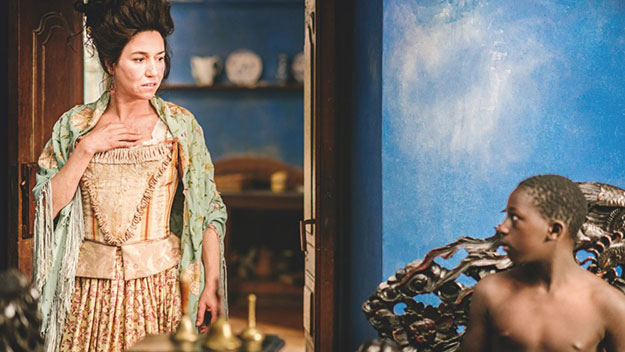
And, to some degree, the same is true with The Holy Girl and The Headless Woman. Zama feels like a departure from that. I’m not sure if it stems from gender or from the landscape perhaps?
I never noticed this. This is really interesting. This movie, for me, has to do with something that women are very familiar with but that the masculine world doesn’t know so much about, and that’s failure. The world of women knows failure much more than that of men. And so it was like I was sharing this with Zama. I think that an important part of the film is a man wanting to hold onto this masculine culture and later accepting something that is more from feminine understanding, which is failure and the liberty that failure brings. In South America, masculine failure causes a lot of violence. A lot of domestic violence. A lot of violence against women. It’s difficult to succeed in work or the economy and so the last remaining terrain for a man is his family or home or spouse, his woman. And if that fails because the woman is in love with another man or wants to separate, the violence is so extreme because everything else is very difficult in our country. When love or family falls apart, the violence is extreme.
I read another interview in which you spoke about how the character of Zama brought out the darkest parts of you. Can say more about that?
I identify with Zama completely. Because the experience of failure is easy to understand. Because we’re always so exposed to everything that is supposed to happen: youth, beauty, great sex, makeup, clothing. We’re filled with advertisements permanently setting the bar for where we have to get, no? We’re extremely aware of what we can’t accomplish. We’re always seeing things that won’t happen to us. And in that sense it’s very easy to identify with Zama. In general, I prefer imperfect, weak, almost bad characters because I feel that there is much more humanity there than in heroes. Good people—good people strike me as the worst in the world.
[Laughs] There’s this moment near the beginning of the film when some women taking a mud bath catch Zama spying on them. They call him mirón, or voyeur, but he’s not actually looking, he’s listening—
Listening! [Laughs] Yes!
Which is funny, but anyway, I wonder if you ascribe to the notion that a filmmaker, a director, is someone who is fundamentally a voyeur—
A voyeur, yes! [Laughs] It’s true: we are voyeurs. But it was important to me that Zama wanted to listen to the women. Me, I’m more like Zama, I’m listening more than looking.
Which I think you can feel in your films, an attention to listening to the world, to apprehending through listening. Is that something you get energy from in your daily life? If you’re in a restaurant or in the street, do you find yourself listening to things and collecting things?
All the time. And I can spend hours talking with someone. I mean, if I could choose a job, it would be conversing with and listening to people. It’s like a dementia setting in. I sense things that aren’t there. I don’t know. But, in speech, the individual dissolves in time. When someone speaks, and it could be a child or an old person, age dissolves. In fact, the film workshops I give involve listening to children’s dialogues. The workshop participants record dialogues they hear in the street or on the phone. They must listen to what happens when someone speaks. In movies there’s dialogue, no? There are two people and the image goes back and forth between them. But when someone speaks they have so many interlocutors. They are speaking with their dad, with their mom. They are speaking with their boss, with a ton of people that maybe aren’t there. So understanding dialogue as something that just goes back and forth between two people is not understanding dialogue. Dialogue is full of phantasmagoria.
When images dissolve in cinema, people generally notice it. But dissolving sounds feel very natural to us. The sound from one scene bleeds into another scene and we just accept it. I wonder if it isn’t because that’s closer to how we experience life. A sound is a little ghost always traveling into the next place. Echoes.
Yes! I believe we have no idea of how sound really affects us. This film, Zama, without the sound, is an absolute disaster. There are many things that only work because of the sound design.
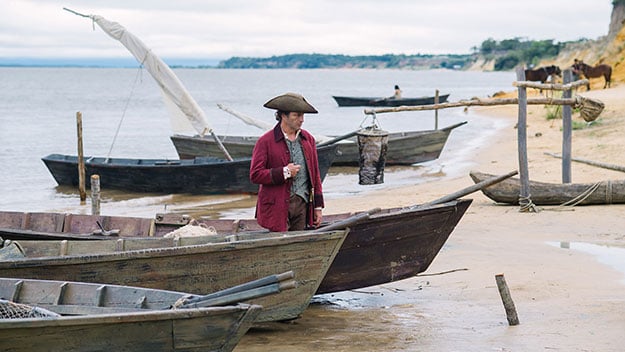
Thinking about sound, about listening, about these aural landscapes, I wonder: do you ever work in radio or in theater?
When I came back to live in my hometown, what I most wanted was to work in radio. Right now I’m staging an opera. In Buenos Aires, the Colón Theatre. It’s my first time. It’s a romantic opera from the 19th century with which I don’t agree for the most part. It’s called Andrea Chénier. An Italian opera about a French poet. Yes, I sometimes think that I would like radio, but I believe that the fascination I have with sound is very linked to images. I don’t know if sound would mean as much for me if it was only sound. It might need to be in relation to creating an image—like the sound is a tool for making an image.
Is your long-gestating science-fiction project abandoned for good?
The producers have rights to the comic book. No, I don’t think this is going to happen. But I would like to do something else about the future. Whenever I imagine the future, I imagine that it’s the same as the present.
[Laughs]
Only a few little things have changed, but it’s the same. I want to think about this. It’s as if everything is exactly the same, just this armchair moves a little bit. Things like that. Or this armchair is an animal. Everything is the same but this armchair is an animal. I would like to work on that.
It’s been nine years since The Headless Woman, but I’m not going to assume that this is necessarily a horrible thing. Maybe you’re just fine with that.
It’s really fine! You know, I don’t care. I think this fantasy around productivity has nothing to do with human experience and everything to do with the marketplace. It seems to me that if you made one film that would already be enough. We have the desire to express ourselves and if there is a very productive person, that person occupies the space of a lot of other people. I think in Argentina, they respect me a little, not only because of my films but also for not making so many films. I don’t have this desire to take up space. I think it’s that. I’m respected more because of that than for anything else I do.
How do you most like to spend your time?
When I’m not making a movie?
Yes. What gives you satisfaction?
Planning. For me, making a movie is making plans. When it’s not a movie, I’m making plans for other things. Maybe they never see the light of day, but for me what’s most attractive is making plans. Therefore, I’m a disaster for a producer. I don’t have the will for a career, to constantly develop, to strive each time for a bigger budget. It doesn’t matter to me. Really, I’m not saying this like a pose. I’m telling you: it really doesn’t matter to me.
José Teodoro is a freelance critic and playwright.



